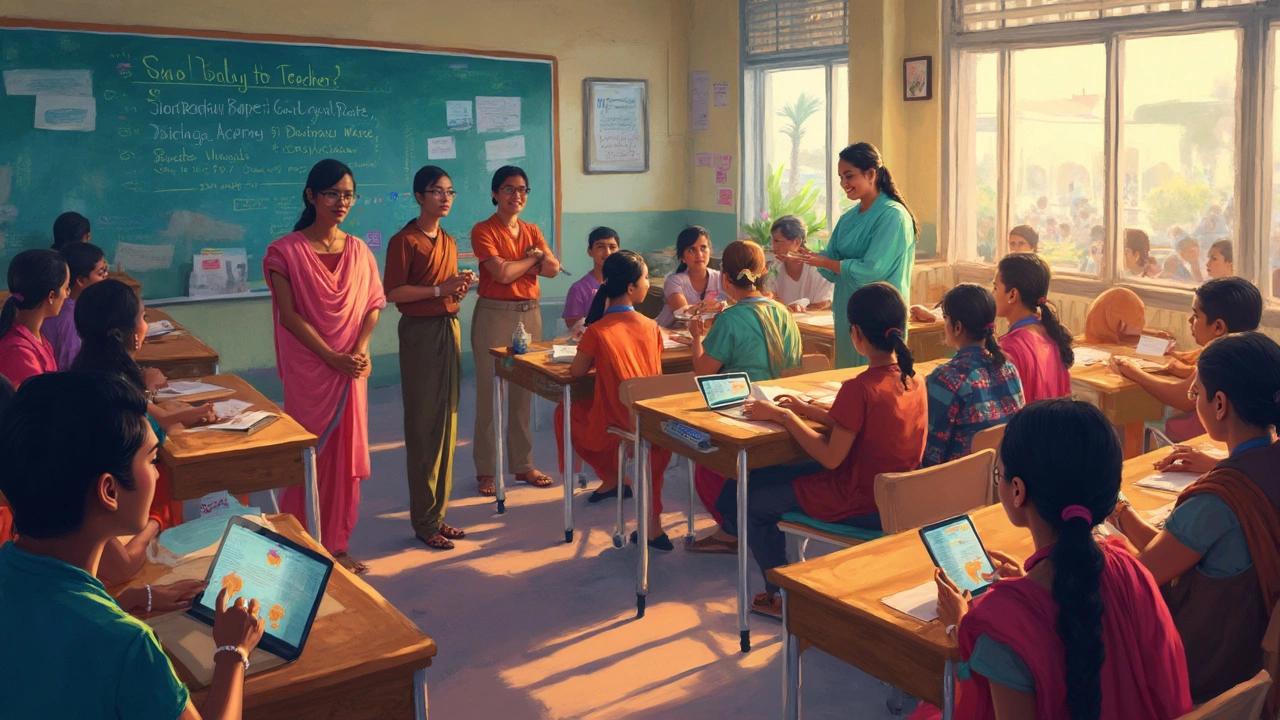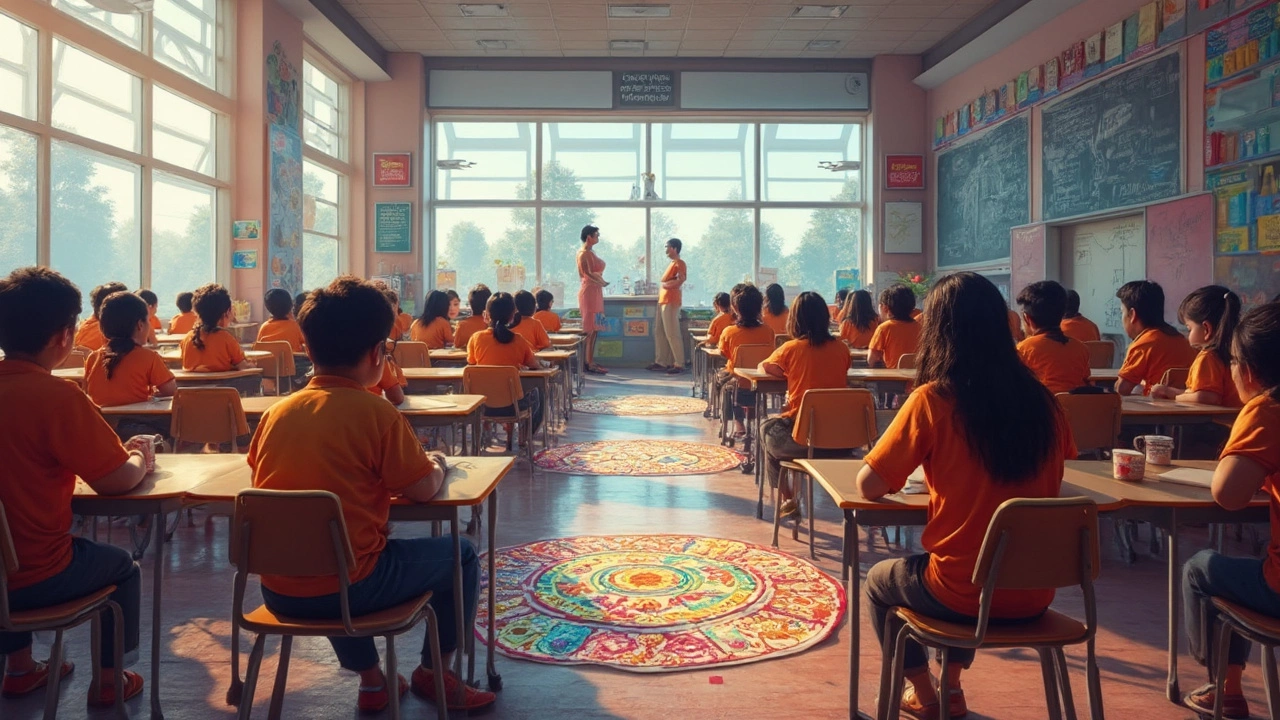Best Training Practices for Teachers
 Feb, 24 2025
Feb, 24 2025
Training for teachers isn’t just about sitting in a stuffy room, staring at slides, or logging in to a never-ending webinar. It's about picking up new skills that genuinely improve classroom dynamics and student learning. The reality is that no single training approach works for everyone. So, how do you figure out what’s best for you as an educator?
First off, understanding the types of training available is key. There are workshops, online courses, certifications, and more informal community-based learning opportunities. Each of these brings something unique to the table. Whether you're looking to integrate more tech into your classroom or aiming to fine-tune your classroom management skills, the options abound.
Continuous learning is not just an educational buzzword—it's essential. Today's classrooms are more diverse and tech-savvy than ever before. Being able to adapt at the drop of a hat means that what you learn must evolve with these changes. So, keeping up with training keeps you ahead of the curve and in sync with your students' needs.
- Understanding Different Training Types
- The Importance of Continuous Learning
- Hands-on versus Online Training
- Tailoring Training to Teacher Needs
- Evaluating Training Effectiveness
Understanding Different Training Types
When it comes to teacher training, the variety of programs can seem overwhelming at first, but knowing what's out there helps you make informed decisions. Let's break it down.
Workshops and Seminars
These are some of the most traditional forms of educational development. They provide hands-on experiences, often in group settings, which is fantastic for networking and exchanging ideas. Topics can range from discipline strategies to innovative tech use in classrooms.
Online Courses
With digital learning thriving, online courses have become a go-to for many teachers. Platforms like Coursera and Khan Academy offer courses tailored specifically for educators, making it easy to learn at your pace, whenever and wherever.
Certification Programs
These programs are usually more comprehensive and can lead to additional credentials. For instance, obtaining a TESOL certification can open doors if you're interested in teaching English to speakers of other languages.
Community-Based Learning
Sometimes the best learning happens through informal channels. Think local meet-ups, teacher associations, or even social media groups. Sharing experiences with fellow educators can be incredibly valuable.
| Training Type | Pros | Cons |
|---|---|---|
| Workshops | Interactive, networking opportunities | Can be expensive |
| Online Courses | Flexible, self-paced | Less personal interaction |
| Certifications | Recognized credentials | Time-consuming |
| Community-Based | Practical, real-life insights | Varied quality |
So, how do you choose? It often depends on your personal and professional goals. Are you trying to adapt new teaching strategies right away, or are you looking to build a long-term skill set? Each type offers something different, ensuring there's something that’s just right for every educator.
The Importance of Continuous Learning
Continuous learning isn’t just about staying busy; it’s about staying relevant and effective in your teaching role. With the education landscape constantly changing, teachers need to be on top of their game to educate and inspire their students. Whether it's new teaching strategies, technological tools, or evolving curriculum standards, teachers can’t afford to fall behind.
Keeping Up with Technological Advancements
Technology is a big player in today’s classrooms. Integrating educational tech effectively can make or break the learning experience. Continuous training helps teachers stay updated with the latest tools and techniques, such as using interactive whiteboards or educational apps, making lessons more engaging and accessible for students.
Adapting to Diverse Classrooms
Classrooms today have students from all walks of life, each with unique needs and learning styles. Through ongoing teacher training, educators learn to adapt their methods to support diverse learners effectively. This includes understanding different cultural contexts and accommodating students with varying learning abilities and interests.
Improving Teaching Strategies
Regular training also introduces teachers to fresh teaching strategies that can enhance their effectiveness. For instance, flipping the classroom or implementing project-based learning can foster deeper student engagement and understanding. Learning from real-world case studies and peer experiences can stimulate new approaches and ideas.
| Training Type | Focus Area |
|---|---|
| Technology Workshops | Using new educational tools |
| Diversity Training | Understanding and supporting diverse learners |
| Innovative Teaching Strategies | Implementing new methods |
By embracing continuous learning, teachers aren’t just improving their skills; they're ensuring their teaching remains relevant and impactful. Staying proactive in education through ongoing development guarantees that teachers not only meet today’s challenges but are also prepared for the future.

Hands-on versus Online Training
The debate between hands-on training and online training is like a classic showdown. Each has its perks and is favored for different reasons.
Hands-on Training
Hands-on training, often called in-person training, offers a chance to dive headfirst into the material. It’s where learning feels tangible. Imagine being in a classroom filled with fellow educators, actively brainstorming solutions to common classroom challenges. You're not just getting information—you’re living it.
One of the biggest benefits is real-time interaction. You’ve got instant feedback from instructors and peers, which is invaluable. For teachers who thrive in interactive environments, this is the way to go. Studies even show that those involved in experiential learning often retain more than those who just read or watch.
Online Training
Now, let’s talk online training. It's the go-to for flexibility and accessing a wealth of global resources from your living room. Perfect for those juggling tight schedules or who prefer learning at their own pace. Most online platforms offer modules you can complete anytime, anywhere. This convenience is a major draw.
Also, online training isn't just reading PDFs or watching videos. Interactive elements like forums, quizzes, and video conferencing are woven into the mix to make learning engaging. For independent learners or tech enthusiasts, online training can be a game changer.
Making the Choice
The choice really boils down to personal preference and learning style. Are you someone who learns by doing, or do you prefer processing information solo before diving into application? Perhaps a hybrid approach, combining both methods, models the best of both worlds.
Here’s a tip: try both types in small doses before committing. A workshop one month and an online course the next can give you a feel for what fits best.
How about a little comparison?
| Feature | Hands-on Training | Online Training |
|---|---|---|
| Interaction | High (In-person feedback) | Moderate (Forums and chats) |
| Flexibility | Fixed schedule | Flexible (Anytime access) |
| Learning Style | Experiential | Self-paced |
Choosing the right teacher training is crucial in keeping up with educational demands. Whether you opt for hands-on, online, or both, investing time in your professional growth will always pay off.
Tailoring Training to Teacher Needs
Every teacher is unique, right? So it makes sense that teacher training shouldn’t be one-size-fits-all. Tailoring educational development to fit personal learning styles and specific classroom challenges can make all the difference.
Identifying Individual Needs
Start by pinning down what you or your school needs. Conduct surveys or informal talks with teachers to figure out what areas they're keen to improve in, whether it’s integrating digital tools, enhancing classroom management, or mastering new teaching strategies.
Personalized Learning Pathways
Once you've got a handle on personal goals, it's time to craft training that hits the mark. Utilize a mix of online and hands-on training strategies to provide flexibility and depth. For instance, workshops for hands-on experience, paired with collaborative online forums for continuous learning.
Incorporating Feedback Loops
Feedback is crucial. It’s not just about attending a course; it’s about applying new skills in real classrooms and then improving them. Create regular check-ins where teachers can discuss what’s working and what’s not, suggesting modifications to the training approach.
Tracking Progress and Outcomes
How do you know if the training is working? Consider setting measurable goals like improved student engagement or increased proficiency in a new tech tool. Use assessments or observation to gauge impact.
A Quick Look at Stats
Here's a bit of data to chew on:
| Training Method | Success Rate (%) |
|---|---|
| Hands-on Workshops | 85 |
| Online Courses | 70 |
| Blended Learning | 90 |
Blended learning typically comes out on top because it offers the best of both worlds. It matches well with the way many teachers prefer to learn, combining flexibility with face-to-face interaction.
By connecting the dots between professional growth goals and practical training, schools can create an environment that supports effective teaching and engaged learning.

Evaluating Training Effectiveness
So, you've completed a teacher training program, but how do you know if it was really worth it? Evaluating the effectiveness of training is crucial to ensure that it leads to meaningful improvements in the classroom.
Key Performance Indicators
One way to measure training success is by looking at specific Key Performance Indicators (KPIs). These could range from student performance metrics to classroom engagement levels. If a training session focused on educational development, for instance, you should see a direct impact on student outcomes.
- Improved student test scores
- Higher student engagement in lessons
- Better classroom management
Feedback Gathering
Another critical tool for evaluating effectiveness is gathering feedback. Ask your students what they're noticing in your teaching methods. You might also survey fellow educators and even administrators to get a full 360-degree view.
Consider questions like:
- Did the training provide new strategies that are applicable?
- Were the resources from the training useful?
- Have you seen noticeable changes in student behavior or understanding?
Real-World Application
A training program is only as good as its real-world application. Are you using the new strategies in your day-to-day? If the professional growth was the goal of the training, you should feel more confident and effective in your teaching role.
Data Review
Reviewing hard data can also shine a light on the training's impact. Some schools even keep a chart tracking performance before and after different training programs, offering a clear picture of effectiveness.
| Month | Average Student Score | Engagement Level |
|---|---|---|
| Before Training | 75% | Moderate |
| After Training | 85% | High |
Ultimately, teaching strategies should evolve based on evidence. If the numbers and feedback show that changes are making a positive impact, then the training has done its job. Keep evaluating, keep growing, and most importantly, keep teaching.